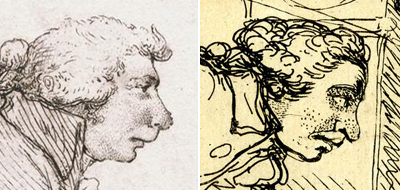[Richard Brinsley Sheridan]
There are two full-length caricature portraits of the playwright and Whig politician Richard Brinsley Sheridan both published on the same day June 29, 1789 and both signed with the logo of Gillray's major competitor in satiric prints, James Sayers. Like most portrait caricatures, the subject of the prints is not specifically identified, but both images can be recognized as representing Sheridan by their resemblance to contemporary portraits and by the scroll in his hand which indicates this he is speaking at Warren Hasting's impeachment trial, where Sheridan, along with Edmund Burke and Charles James Fox, played a major role.
![[Sheridan]](../images/bm_sheridan.jpg)
© Trustees of the British Museum
Most commentators agree that this print is almost certainly by Gillray, imitating the manner of Sayers and his signature logo. It was published by James Aitken with whom Gillray was working frequently at the time (nine other prints in May and June); it is coloured (which Sayers' prints almost never were); and Gillray was sometimes known to hide his identity by imitating the manner of other artists. The imitated logo has an extra curlicue on the S of Sayers, however, making it closer to a G which may be Gillray's wink and nod to his true identity as author. Its companion, also published by Aitken, and also signed with Sayers' logo, was a portrait of Lord High Chancellor Edward Thurlow, who, like Sheridan, was heavily involved in the Hastings trial—in his case as Lord High Steward.
![[Edward Thurlow]](../images/lwl_thurlow.jpg)
© Lewis Walpole Library, Yale University
The prints of Sheridan and Thurlow are just two instances among others at this time of Gillray parodying Sayers and using his logo in what seems to be a deliberate attempt to sow confusion and discredit Sayers by providing an alternative narrative to the one provided by Sayers himself, making it difficult to know which Sayers to believe. Others include The Impeachment Ticket (February), A Dish of Mutton Chops (March 28), The Bow to the Throne, alias the Begging Bow (May 6), Camera Obscura (May 9), and State Jugglers (May 16). And for those who knew that Gillray was behind the faux Sayers prints, it invited a kind of one to one comparison between the two caricaturists portraying the same subject. Needless to say, Gillray ultimately won that contest.
The second "signed"print of Sheridan published on June 29 is more problematic. At 17.8 x 11.4 cm, it is essentially the same size as the 24 portrait caricatures Sayers produced in April through July of 1782 and the eight more in July of 1784. Like those, it is a full length portrait and uncoloured. The etching of the print too is similar to Sayers with extensive use of parallel lines to denote colour. And the figure of Sheridan leans almost unnaturally forward like the Sayers prints of Sir James Erskine and Mr. Thomas Powys.
![[Sheridan]](../images/lwl_sayers-sheridan.jpg)
© Lewis Walpole Library, Yale University
But unlike other Sayers' prints, which were etched and published by Charles and James Bretherton, this one is listed as published by Samuel Fores, who had never worked with Sayers until this print, and, so far as I can tell, never did so him again. So it is most likely that this image, like the one above, is not by Sayers at all but a parody of his style. The Lewis Walpole Library commentary on this print suggests that it might have been created by Gillray who did, in fact, work with Fores even more frequently than he did with Aitken in 1788/89. But it seems unlikely that Gillray would have created another image of Sheridan for Fores in direct competition with the one he did for Aitken. So we are left to guess who might have been the author.
My vote is for Thomas Rowlandson. Rowlandson produced over 20 prints for Fores in 1789. At least one of them, Neddy's Black Box (January 30, 1789) was "signed" with the faux logo of Sayers. So if this is Rowlandson using Sayer's logo, it would not have been the first time. And a comparison of the face of Sheridan in the questionable Sayers print and Rowlandson's Loose Principles (January 21, 1789) reveals some similarity. The etching of the print, however, is cleaner and more precise than is typical with Rowlandson. So though I feel reasonably certain that the face is a Rowlandson face, the etching may owe something to Rowlandson's drinking buddy, Gillray.

© Trustees ofthe British Museum, Lewis Walpole Library, Yale University
Sources and Reading
- Commentary from the British Museum on [Sheridan].
- "Richard Brinsley Sheridan," Wikipedia
- "James Sayers," Wikipedia
- "Impeachment of Warren Hastings," Wikipedia
Comments & Corrections
NOTE: Comments and/or corrections are always appreciated. To make that easier, I have included a form below that you can use. I promise never to share any of the info provided without your express permission.